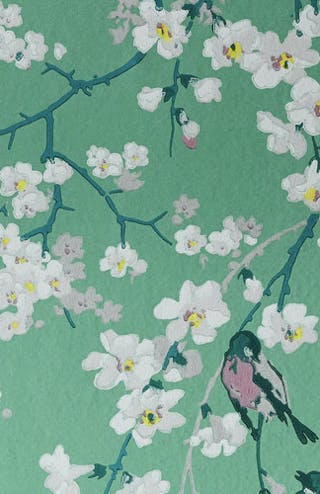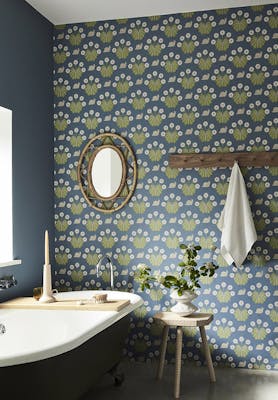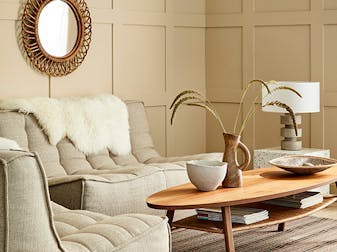
National Trust Papers II
‘National Trust Papers II’ comprises 42 colourways across seven designs; the collection is a celebration of enduring design, with the origins of these contemporary wallpapers spanning over 400 years of historic decoration. Each wallpaper in the collection has been redrawn and recoloured, whilst respectfully acknowledging the traditional methods and materials from which they were originally crafted. Design elements are taken from Georgian and Victorian block-printed papers and also from older, decorative objects including a leather wall-hanging and a 15th century tapestry. The contemporary interpretation of each design makes this a truly timeless collection of papers for homes of all architectural styles.
Massingberd Blossom (Gunby Hall) c.1905
The wallpaper from which this design is drawn, is most likely of British Edwardian origin, but stylistically is very representative of the era’s passion for oriental design, which – in a time of pre-modern artistic sensibility - was seen to retain a close connection to nature, simplicity and harmony. The trailing blossom and repeating birds are elements commonly found in early, hand-painted chinoiserie, and the use of traditional surface printing retains a tactile quality that subtly offers more to the discerning eye than a conventionally mass-produced paper. It once adorned the walls of the Grey Room at Gunby Hall in Lincolnshire, a large country house built some 200 years earlier for the Member of Parliament William Massingberd, that was bequeathed to the National Trust in 1944.
Available in 7 colours : Verditer, Deep Blue, Pale Blue, Oriental, Mineral, Yellow and Grey.
Mandalay (Bateman’s) c.1712
This tree of life design is drawn directly from the leather wallcoverings in the dining room at Bateman’s, a Jacobean mansion in East Sussex. Elaborate designs such as these were inspired by 17th-century Indian chintzes, which often depicted sinuous flowering trees with birds among their branches. Leather hangings foreran wallpaper as we know it today, and although panels of this kind required a different skill to create, the process by which early wallpapers were hung, and their decorative effect in the room, is very similar. Documented as Dutch in origin, Mr & Mrs Rudyard Kipling paid 100 guineas for them in 1902, having recently bought Bateman’s as their family home. The paper versions are printed on a wide (70cm) roll and the pattern has been adapted to repeat effortlessly and continuously along the wall.
Available in 4 colours: Archipelago, Ceviche, Pollen and Arbour.
Tulip (Erddig, Wrexham) c.1898
Considered to be one of Britain’s finest country houses, Erddig, just outside Wrexham in North Wales, is home to an abundant collection of wallpapers. Some still adorn the walls of the state rooms, but many more have been found as samples in tea-chests in the attic rooms. At the turn of the 20th century, they were collected by Philip and Louisa Yorke, who were recently married and committed to the redecoration of Erddig, their new family home. This pattern of scrolling foliage is unusual in its execution; the graded colour which gives life and depth to the leaves was, even in 1898, a contemporary evolution of the traditional, flat damask design.
Available in 7 colours: Powder Blue, Aqua, Cloud, Pale Grey, Sugar, Theatre and Blue Black.
Beech Nut (Oxburgh Hall) c.1782
An authentic, late Georgian design, this paper was uncovered at Oxburgh Hall in Norfolk. Originally used within a brightly-coloured, flocked, floral border, the leaf and nut element was block-printed in a rather more subdued grey colourway. While its six contemporary interpretations are unashamedly more colourful, each one uses a similarly balanced colour palette alongside the signature, crafted texture of a surface-printed paper.
Available in 6 colours: Cordoba, Summer, Delicate, Rubine, Florence and Warm Grey.
Burges Snail (Knightshayes Court) c.1878
Built between 1869 and 1874, Knightshayes Court in Devon was designed for the Heathcoat Amory family by the Gothic Revivalist architect and interior designer William Burges. An eccentric and, at-times, controversial character, he designed some of the most original and extravagant Victorian interiors, sometimes while dressed in medieval costumes. This quirky, charming wallpaper adorns the walls of one of the bathrooms and, whilst it’s known to be his design, was introduced in a later restoration, following a period of many years during which subsequent generations of the family tried to minimise the house’s elaborate High Victorian Gothic styling.
Available in 7 colours: Ocean, Dark Blue, Travertine, Lemon, Silver, Juniper and Rosie.
Millefleur (Montacute House) c.1478
The floral detail in this design is drawn directly from an incredibly rare, important and lovingly-conserved object, the oldest tapestry in the care of the National Trust. Residing at Montacute House in Somerset, the 10m2 piece is woven from wool and silk and depicts a knight against backdrop of hundreds of tiny flowers on a dark background. It was made in the 15th century as part of a much larger set, and given by the city of Tournai, in Belgium, to Jean de Daillon, a French nobleman and Governor of Dauphine.
Available in 4 colours: Chambray, Garden, Knight and Masquerade.
Moy (The Argory) c.1875
Little is known about this small-scale print found at The Argory, just outside Moy in Northern Ireland. The surviving fragment is estimated to be late-19th century in origin, and was printed using diluted watercolours rather than a more conventional, substantial ink or even opaque paint. This slightly broken effect, combined with the shadowing seen within the loose geometric pattern, gives a life to the design that would be difficult to achieve straight from the drawing board.
Available in 7 colours: Pink, Red Ochre, Lime, Blue, Ash, Pompei and Mall.
Burges Snail - Juniper Bathroom

“We are immensely privileged to have access to the National Trust’s incredible portfolio of properties, that are so beautifully looked after and treasured by the Trust on behalf of the nation. With the National Trust properties each containing such diverse decoration, creating a collection that encompasses the wide-ranging styles found in these historically significant interiors is a real joy.” Creative Director, Ruth Mottershead.Learn more about our partnership with the National Trust
National Trust Partnership
Since the beginning of 2018, in collaboration with their curators and conservators, an extensive paint research project has been undertaken in National Trust houses and gardens to find original colours, and to tell the stories of the people who first enjoyed them.
Find out more
National Trust Paint












































